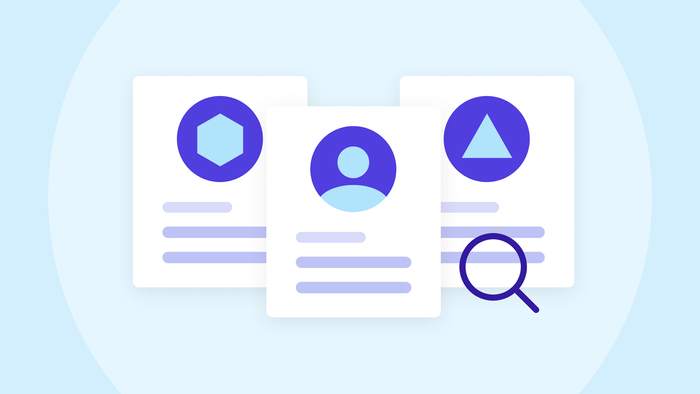When I joined Bubble as a senior user researcher nine months ago, I was thrilled by the opportunity to work at a startup that’s still in an exciting growth stage. Many tech companies wait until they’re much larger to build out a dedicated research team, so I looked forward to putting my skills to work at a smaller company. Since then, I’ve had the chance to create Bubble’s first user journey map, implement a usability scoring metric, and usability test the upcoming native mobile editor — and we’re just getting started!
Today, I want to share an inside look into the work Bubble’s User Research team does and how we incorporate your feedback into the development of our product.
Who Bubble’s User Research team is and what we do
Our team’s mission is to make sure Bubble’s high-level product strategy and granular product solutions meet our users’ needs. The User Research team was founded in 2021 because Josh and Emmanuel recognized that our users and their feedback are the keys to Bubble’s success.
Today, we’re a small but mighty team of three, with researchers embedded into every product team at Bubble. We work primarily in qualitative research methods and partner closely with Bubble’s Data team for quantitative insights.
Types of user research projects we conduct
Research projects fall into one of two broad categories: tactical research or strategic research. These categories aren’t methodologies, but rather describe how we use the research insights.
- Tactical research is conducted with a dedicated product team and scoped to one surface area. For example, Bubble’s AI build guides were launched by our Activation team based on insights from tactical app planning research.
- In contrast, strategic research is broader, higher-level research that influences Bubble’s long-term product strategy, but isn’t directly tied to a specific product team. For example, we conducted user interviews to create a user journey map that our product and design teams reference when brainstorming new features.
The differences between tactical and strategic research also influence the timeline of their impact. Tactical research insights are more likely to be implemented and shipped rapidly, while strategic insights take longer to take shape and morph into a product solution.
How we incorporate research insights into the development process
The research we do influences every stage of the product development cycle:
- Before a product or feature launches, we start by determining the underlying problems to be solved and the jobs to be done. To define the problem space, we might conduct exploratory interviews, do a literature review of existing research, or peek on the Bubble forum to see any existing community discussion on a topic.
- As features are built, we conduct usability testing on design decisions and patterns and make updates based on user feedback.
- At launch, we measure ease of use and customer satisfaction. We also monitor usage analytics to compare how often a feature gets used against how satisfied people are with the feature. If you’ve ever responded to a short survey that popped up in the corner of your Bubble editor, you’ve already participated in a launch research study!
- Post-launch, we conduct additional research to gather data on how to iterate and improve the product. For example, our post-launch research on the new elements tree led to follow-up optimizations like auto-saving element name edits, directly opening the property editor for an element from the tree, and updated show/hide behavior for child elements.
We take everyone's feedback into account, but one of the most fun parts about user research is that people tend to have lots of different opinions. If you've ever given us feedback during this process that you didn't see reflected in the final product, rest assured that we heard you — we just need to take all the research insights we receive at a more holistic level and consider the needs of Bubble users at different stages in the user journey.
How you can participate in user research
We're so lucky to have such an engaged, passionate community, and we’re grateful that so many of you are eager to participate in user research and share your feedback. So far in 2024, we have:
- Received 6,542 survey responses across 17 emailed or in-product surveys
- Conducted 222 user interviews with 208 unique users
- Gathered feedback from 103 participants in three alpha and beta testing programs
We want to thank every one of you who have participated in and contributed to user research at Bubble in some way! Your contributions are what allows us to continually improve Bubble and evolve our platform to meet your needs.
If you’d like to participate in future user research, we have plans to conduct several different types in the near future:
- Surveys: sent via email, or sometimes presented directly in the Bubble editor. While surveys aren’t paid, we do often raffle off gift cards or Bubble credits as incentives. We also very frequently recruit participants for paid research opportunities based on responses from previous surveys.
- User interviews: a call with someone on our team, typically between 30 minutes and one hour. User interviews vary by project, but may include giving your feedback on a design prototype, walking through your Bubble app, or discussing a product idea. Participants are paid as a token of thanks after the interview is over.
- Rapid research: a specific type of user interview, typically 30 minutes long and conducted on Tuesday or Wednesday. Invitations for rapid research are often sent with shorter notice, around a week before the interview. Participants are paid as a token of thanks after the interview is over.
- Unmoderated user testing: asynchronous feedback sessions conducted using video and screen recording software. Participants are paid after we verify that they’ve successfully completed the unmoderated test.
- Beta testing: gaining early access and providing feedback on a new product feature. Participation in a beta program itself isn’t paid, but we often recruit beta testers to participate in paid interviews.
To express interest in any of these future research opportunities, you can join our Bubble Early Testing Advisory (BETA). Keep in mind, though, while we’d love to hear from everyone interested, time constraints usually make that impossible — plus, sometimes we’re looking for specific criteria and want to select participants that best fit the research study.
Still, we’d love to have you join the list, and we’ll reach out if and when the time comes. Talking to users and getting to know your stories is one of my favorite parts of working at Bubble, and I’m looking forward to meeting more of you in a research session soon!
Build for as long as you want on the Free plan. Only upgrade when you're ready to launch.
Join Bubble







